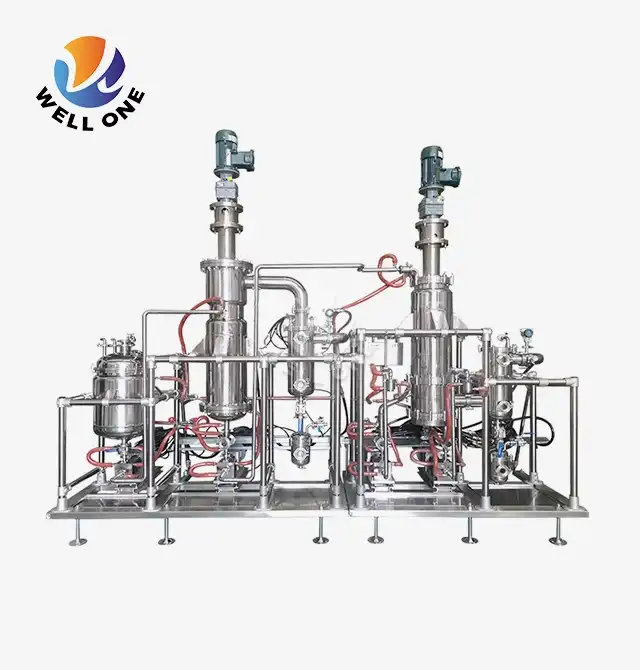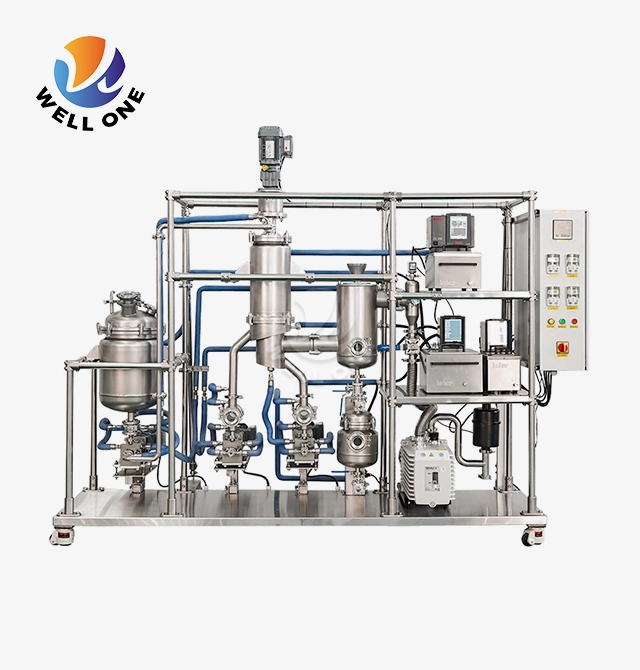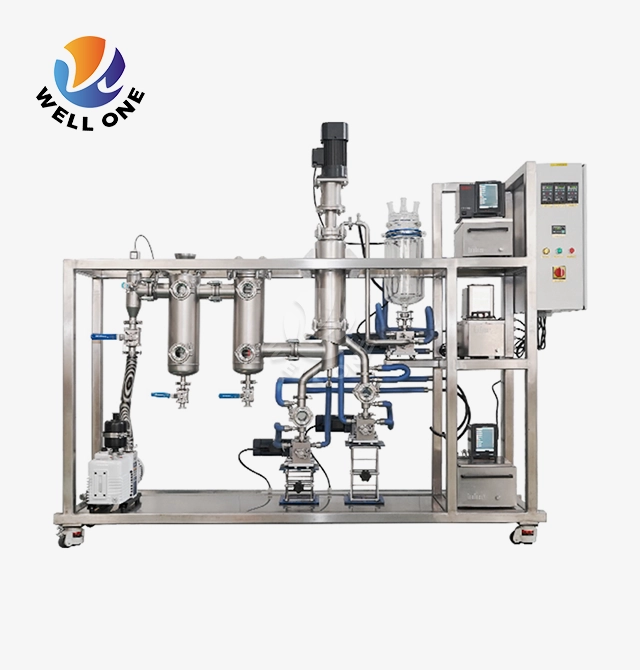How Molecular Distillation Works: A Look Inside the Equipment
When processing heat-sensitive compounds like pharmaceutical APIs or essential oils, traditional distillation often causes thermal degradation, resulting in product loss and reduced purity. Laboratory Molecular Distillation offers a revolutionary solution by operating under ultra-high vacuum conditions (as low as 0.1Pa), enabling separation at temperatures 50-100°C lower than conventional methods. This technology preserves molecular integrity while achieving purities exceeding 98%, making it indispensable for industries demanding uncompromised quality and efficiency in their separation processes.
Understanding Laboratory Molecular Distillation Technology
Laboratory Molecular Distillation represents a paradigm shift in separation science, distinguished by its ability to operate at extremely short distances between the evaporating and condensing surfaces—typically just a few centimeters. Unlike conventional distillation that relies on boiling point differences at atmospheric pressure, this technique exploits the mean free path of molecules under high vacuum. When pressure drops below 0.001 mbar, molecules can travel from the heated evaporator surface directly to the cooler condenser without intermolecular collisions, enabling separation based purely on molecular weight differences rather than volatility. The fundamental principle revolves around creating conditions where lighter molecules possess sufficient kinetic energy to escape the liquid film and reach the condenser, while heavier molecules remain in the residue. This mechanism proves particularly advantageous for thermally labile substances that decompose before reaching their atmospheric boiling points. Advanced Laboratory Molecular Distillation systems incorporate precision temperature controls (50°C-300°C range), ensuring optimal separation without thermal stress. The 316L stainless steel construction provides corrosion resistance essential for handling aggressive chemicals across pharmaceutical, food, and petrochemical applications.
Core Components of Laboratory Molecular Distillation Systems
The evaporator constitutes the heart of any Laboratory Molecular Distillation unit, featuring a cylindrical heated surface where feedstock forms a thin film through centrifugal force or mechanical wiping action. Modern systems employ rotary wipers with adjustable speeds (20-400 rpm) to maintain uniform film thickness of 0.05-0.5mm, maximizing surface renewal rates and heat transfer coefficients up to 1500 W/m²K. The evaporation surface area ranges from 0.1m² for laboratory-scale units to 2m² for pilot production, with modular designs allowing seamless scalability. Integrated condensers positioned mere millimeters from the evaporator capture vaporized light fractions instantly through chilled surfaces maintained at -10°C to +50°C via ABB PLC-controlled cooling systems. Internal condensers utilize helical coil designs to maximize cooling capacity while minimizing pressure drops, achieving condensation efficiencies exceeding 99.5%. External condenser configurations suit applications requiring solvent recovery or handling highly volatile components. The vacuum system, comprising multi-stage rotary vane and diffusion pumps, maintains ultimate pressures below 0.001 mbar with leak rates under 10⁻⁶ mbar·L/s, certified through rigorous helium leak testing per ISO 3530 standards.
Operational Workflow in Laboratory Molecular Distillation
Process initiation begins with feedstock preheating to optimal viscosity (typically 50-100 mPa·s) through jacketed feed tanks equipped with nitrogen blanketing to prevent oxidation. Peristaltic or gear pumps deliver material at controlled rates (0.5-50 kg/hr) onto the rotating evaporator surface, where distributor rings ensure uniform film formation. As the thin film travels downward under gravity, continuous wiper blade action disrupts boundary layers, reducing residence time to 2-15 seconds—critical for preserving heat-sensitive actives like CBD isolates or vitamin E acetate. Temperature gradients drive molecular evaporation, with distillate vapors traversing the short-path distance (2-5 cm) to the condenser in microseconds. The condensed light fraction collects in dedicated receivers under vacuum, while heavy residue exits through a bottom discharge valve into separate collection vessels. Multi-stage configurations cascade residue from one stage as feedstock to subsequent units, enabling fractional separation into narrow boiling ranges. Process monitoring through integrated sensors tracks temperature (±0.1°C accuracy), vacuum level (±0.001 mbar), and flow rates in real-time, with data logging compliant with FDA 21 CFR Part 11 for pharmaceutical applications.
Key Advantages of Laboratory Molecular Distillation Equipment
Laboratory Molecular Distillation delivers unparalleled benefits for separating thermally sensitive compounds, starting with its ability to operate at temperatures 100-150°C below conventional distillation methods. This gentle thermal treatment preserves delicate molecular structures in natural extracts, preventing degradation pathways like oxidation, polymerization, or isomerization that plague traditional processes. For instance, fish oil purification via four-stage Laboratory Molecular Distillation achieves 80% EPA+DHA concentrates with minimal peroxide formation, compared to just 16% recovery through conventional deodorization routes that generate off-flavors and nutrient losses. The ultra-high vacuum environment (0.1Pa to 0.001 mbar) eliminates dissolved oxygen and moisture, crucial for processing hygroscopic or oxidation-prone materials such as polyethylene glycol (PEG) or squalene. Short residence times of 2-15 seconds minimize thermal exposure, with cumulative heat history under 5 minutes even in multi-stage setups—orders of magnitude lower than batch distillation's hours-long processing cycles. This kinetic advantage translates directly into higher product yields (70-95% vs. 30-60% for traditional methods) and superior purity levels routinely exceeding 98%, meeting stringent pharmaceutical excipient standards.
Material Construction and Quality Assurance
Every component contacting process fluids features 316L stainless steel construction with electropolished finishes (Ra<0.4μm), providing exceptional corrosion resistance against acids, chlorides, and organic solvents while preventing product contamination. Wetted gaskets utilize FDA-compliant PTFE or Viton materials, tested for extractables below USP <661> limits. Welded joints undergo 100% radiographic inspection per ASME BPE standards, ensuring zero crevices where bacteria or residues might harbor—essential for GMP compliance in pharmaceutical and food-grade applications. Manufacturing under ISO 9001:2015 certified quality systems includes rigorous Factory Acceptance Testing (FAT) protocols covering vacuum integrity (helium leak detection), temperature uniformity (±2°C across evaporator), and material balance verification (>99% closure). Each Laboratory Molecular Distillation system ships with comprehensive documentation: material certificates (EN 10204 3.1), dimensional inspection reports, and calibration certificates traceable to NIST standards. CE marking confirms compliance with EU Machinery Directive 2006/42/EC and Pressure Equipment Directive 2014/68/EU, while optional ATEX certification suits installations in explosive atmospheres per IEC 60079 specifications.
Process Control and Automation Features
Modern Laboratory Molecular Distillation equipment integrates ABB PLC control systems offering ±0.1% accuracy in temperature regulation through cascade PID loops that compensate for feedstock property variations. Touchscreen HMIs display real-time process graphics, trend charts, and alarm management, with remote access capabilities via industrial Ethernet protocols (Profinet, Modbus TCP). Recipe management stores up to 100 process parameter sets, enabling one-button changeover between products while maintaining audit trails of operator actions and parameter adjustments. Advanced systems incorporate inline analytical instrumentation: refractive index sensors monitor distillate purity continuously, viscometers track residue properties, and mass flow meters verify material balance closure to ±0.5%. Automated sequencing handles startup/shutdown procedures, CIP (Clean-In-Place) cycles using hot caustic or solvent washes, and SIP (Sterilize-In-Place) routines reaching 121°C for 30 minutes—all documented through electronic batch records. Predictive maintenance algorithms analyze bearing vibration, vacuum pump performance, and wiper blade wear patterns, scheduling service interventions before failures occur to maximize uptime above 95% annually.
Industrial Applications of Laboratory Molecular Distillation
Pharmaceutical manufacturing relies extensively on Laboratory Molecular Distillation for purifying active pharmaceutical ingredients (APIs) sensitive to thermal degradation. Production of narrow-distribution polyethylene glycol (PEG) excipients exemplifies this application: while traditional batch reactors yield PEG with dispersity indices around 1.05 containing mixed molecular weights, microchannel synthesis followed by Laboratory Molecular Distillation refining achieves single-distribution PEG (dispersity <1.02) at throughputs of 50-200 kg/hr. This precision proves critical for controlled-release drug formulations and PEGylated biologics where molecular weight uniformity directly impacts pharmacokinetics. Squalene purification represents another vital pharmaceutical application, processing crude extracts from plant sources (amaranth, olive) or biosynthetic fermentation broths. Multi-stage Laboratory Molecular Distillation removes fatty acid esters, waxes, and triglycerides while recovering residual extraction solvents (hexane, ethanol) for reuse, achieving final squalene purities of 98%+ suitable for vaccine adjuvants and cosmetic formulations. The gentle processing preserves squalene's unsaturated structure, preventing oxidation to squalane that diminishes biological activity. Single-pass yields reach 85-92% compared to 60-70% for conventional vacuum distillation combined with chromatographic polishing.
Food Industry Processing Solutions
Fish oil enrichment showcases Laboratory Molecular Distillation's capability to concentrate omega-3 fatty acids (EPA and DHA) from crude ethyl ester feedstocks containing 20-30% active content. The four-stage cascade configuration first removes free fatty acids and saturated fats in stages 1-2, then progressively concentrates EPA+DHA to 60%, 75%, and finally 80%+ in subsequent stages. Operating temperatures of 120-160°C under 0.001 mbar vacuum prevent thermal degradation of polyunsaturated bonds, maintaining low peroxide values (<5 meq/kg) and preserving delicate flavor profiles without fishy odors. Tea oil (Camellia oleifera) deacidification demonstrates Laboratory Molecular Distillation's effectiveness for edible oil refining without chemical treatments. Traditional alkaline refining removes free fatty acids but also strips valuable phytosterols, tocopherols, and squalene while generating soap-laden wastewater requiring costly treatment. In contrast, physical refining via Laboratory Molecular Distillation selectively evaporates free fatty acids (typically 2-8% in crude tea oil) at 180-220°C under high vacuum, reducing acid values below 0.3 mg KOH/g while retaining 95%+ of nutraceutical components. This clean process aligns with consumer demand for minimally processed, chemical-free food products.
Specialty Chemical and Petrochemical Applications
Epoxy resin purification utilizes two-stage Laboratory Molecular Distillation to produce ultra-low chlorine grades (<500 ppm total chlorine) demanded by aerospace and microelectronics industries. The first stage removes low-boiling impurities (solvents, unreacted phenols) while preheating feed to optimal viscosity, then the second stage separates oligomeric fractions by molecular weight, eliminating high-chlorine species and color bodies. Final resin exhibits exceptional clarity (Gardner color <1), low ionic contamination (<10 ppm chloride), and narrow molecular weight distribution (polydispersity <1.3), meeting stringent specifications for electronic encapsulants and structural adhesives. Waste lubricating oil regeneration addresses environmental and resource conservation imperatives, processing used motor oils contaminated with oxidation products, metal particles, and combustion residues. Following pre-treatment (filtration, clay contacting), Laboratory Molecular Distillation recovers valuable base oil fractions across three viscosity grades: light spindle oils (32-68 cSt), medium machinery oils (100-150 cSt), and heavy gear oils (220-460 cSt). The residual asphaltene-rich bottoms find application as fuel oil or asphalt modifiers. Overall base oil recovery reaches 75-82% compared to 50-60% for acid-clay chemical refining, eliminating hazardous waste generation and reducing processing costs by 30-40%.
Technical Specifications and Configuration Options
Xi'an Well One Chemical Technology supplies Laboratory Molecular Distillation systems in single-stage, dual-stage, and three-stage configurations, engineered to match specific separation requirements and production scales. Single-stage units suit applications requiring straightforward separation into light distillate and heavy residue fractions, with evaporation surface areas from 0.1m² (laboratory R&D) to 2m² (pilot production processing 5-50 kg/hr). Dual-stage cascades enable intermediate fraction recovery, ideal for concentrating target compounds while removing both lighter volatiles and heavier contaminants—typical throughputs span 10-100 kg/hr depending on feedstock properties and desired purification levels. Three-stage systems deliver maximum separation efficiency for complex mixtures, producing multiple narrow-boiling-range products plus a concentrated residue suitable for further processing or disposal. Pharmaceutical-grade configurations feature CIP/SIP capabilities with spray ball coverage ensuring all wetted surfaces achieve validated cleanliness (<50 μg/cm² residue limits per ISPE baseline guide). Temperature control spans 50°C-300°C via jacketed heat transfer fluids (Therminol, Marlotherm) or direct electrical heating with ±1°C uniformity across the entire evaporator surface. Vacuum systems maintain ultimate pressures below 0.001 mbar through combination rotary-vane and diffusion pump assemblies, with cold traps capturing volatile solvents before vacuum pumps to extend service intervals.
Certification and Compliance Standards
All Laboratory Molecular Distillation equipment manufactured by Xi'an Well One Chemical Technology meets CE marking requirements, demonstrating conformity with European safety, health, and environmental protection standards including the Machinery Directive (2006/42/EC), Pressure Equipment Directive (2014/68/EU), and Low Voltage Directive (2014/35/EU). Electrical components carry UL or CSA certification for North American installations, with control panels built to NEMA 4X standards providing IP66 ingress protection against dust and water. Pressure vessels undergo hydrostatic testing at 1.5x maximum allowable working pressure, documented through stamped U-Forms per ASME Section VIII Division 1 code. ISO 9001:2015 quality management certification covers the entire production process from design review through final testing and commissioning support. Documentation packages include detailed P&IDs, electrical schematics, material certificates traceable to mill test reports, dimensional inspection data, and surface finish verification via profilometry. For pharmaceutical applications, designs incorporate GMP requirements: sloped surfaces eliminate liquid holdup zones, tri-clamp connections enable tool-free disassembly, and all instruments feature sanitary process connections (DIN 11851, SMS 1145). Optional FDA 21 CFR Part 11 compliant data acquisition systems maintain electronic signatures and audit trails for regulatory inspections.
Warranty and After-Sales Support
Standard warranty coverage includes 12 months from commissioning date (maximum 18 months from shipment) covering defects in materials and workmanship, with critical components like vacuum pumps and mechanical seals protected for 24 months. Extended warranty programs offer up to 5 years comprehensive coverage including preventive maintenance visits, calibration services, and priority spare parts supply. On-site commissioning and operator training ensures proper startup procedures, safety protocols, and routine maintenance practices, typically conducted over 5-7 days by factory-certified engineers. Technical support operates through multiple channels: 24/7 emergency hotline for critical production issues, email support (info@welloneupe.com) responding within 4 business hours, and remote diagnostic access via VPN connections for real-time troubleshooting. Spare parts inventory stocks consumables (gaskets, wipers, bearings) and critical wear components with same-day shipping for emergency orders. Annual preventive maintenance contracts include comprehensive inspections, vacuum leak testing, temperature uniformity surveys, and performance verification runs, documented through detailed service reports. Upgrade pathways exist for incorporating new automation features, expanded capacity, or compliance with evolving regulations as customer needs develop.
Conclusion
Laboratory Molecular Distillation represents the pinnacle of separation technology for heat-sensitive, high-value compounds across pharmaceutical, food, and specialty chemical industries. Its unique ability to operate at ultra-high vacuum and low temperatures preserves molecular integrity while achieving exceptional purity and recovery rates. With 316L stainless steel construction, ABB automation controls, and comprehensive certifications (CE, ISO, UL), these systems deliver reliable, scalable solutions from laboratory research through full industrial production.
Cooperate with Xi'an Well One Chemical Technology Co., Ltd
Since 2006, Xi'an Well One Chemical Technology Co., Ltd. has specialized in synthesis and purification separation equipment, backed by Xi'an NewSet Chemical Equipment Technology Co., Ltd. With comprehensive facilities including a 1500m² office, 500m² R&D laboratory, and 4500m² factory, the company delivers complete solutions from process development through equipment design, testing, and pilot services. Our expert team provides molecular distillation devices spanning laboratory to industrial scales, ensuring production capacity and product quality across pharmaceutical, food, new materials, petrochemical, essence, and fine chemical industries.
Our commitment to excellence manifests through four core pillars: Premium Quality through selected materials ensuring top-grade products; OEM & ODM capabilities featuring custom designs with 3D animation; Comprehensive Service covering R&D, production, sales, and technical support; and our Own Factory covering over 5000m² equipped with CNC machining centers, advanced processing machinery, and state-of-the-art assembly facilities. As a trusted China Laboratory Molecular Distillation factory, China Laboratory Molecular Distillation supplier, and China Laboratory Molecular Distillation manufacturer, we offer China Laboratory Molecular Distillation wholesale opportunities with competitive Laboratory Molecular Distillation price points. Our High Quality Laboratory Molecular Distillation systems are available for sale worldwide, supported by 19 years of industry experience and UL, CE, ISO, and SGS certifications.
Transform your separation challenges into competitive advantages with equipment engineered for precision, reliability, and scalability. Whether you're refining pharmaceutical APIs, concentrating nutraceutical extracts, or recovering specialty chemicals, our technical team designs customized solutions optimized for your specific materials and production goals. Contact us today at info@welloneupe.com to discuss your application requirements, request detailed technical specifications, or arrange factory visits. Save this article for quick reference whenever you need expert guidance on molecular distillation technology—your partner for purification excellence awaits.
References
1. Perry RH, Green DW. "Perry's Chemical Engineers' Handbook, 8th Edition." Section 13: Distillation. McGraw-Hill Professional, 2008.
2. Batistella CB, Maciel MRW. "Molecular Distillation: Rigorous Modeling and Simulation for Recovering High-Value Products from Edible Oils." Applied Biochemistry and Biotechnology, 2001.
3. Cvengros J, Lutisan J. "Mean Free Path of Molecules on Molecular Distillation." Chemical Engineering Journal, 1995.
4. Martins PF, Ito VM, Batistella CB, Maciel MRW. "Free Fatty Acid Separation from Vegetable Oil Deodorizer Distillate Using Molecular Distillation Process." Separation and Purification Technology, 2006.







